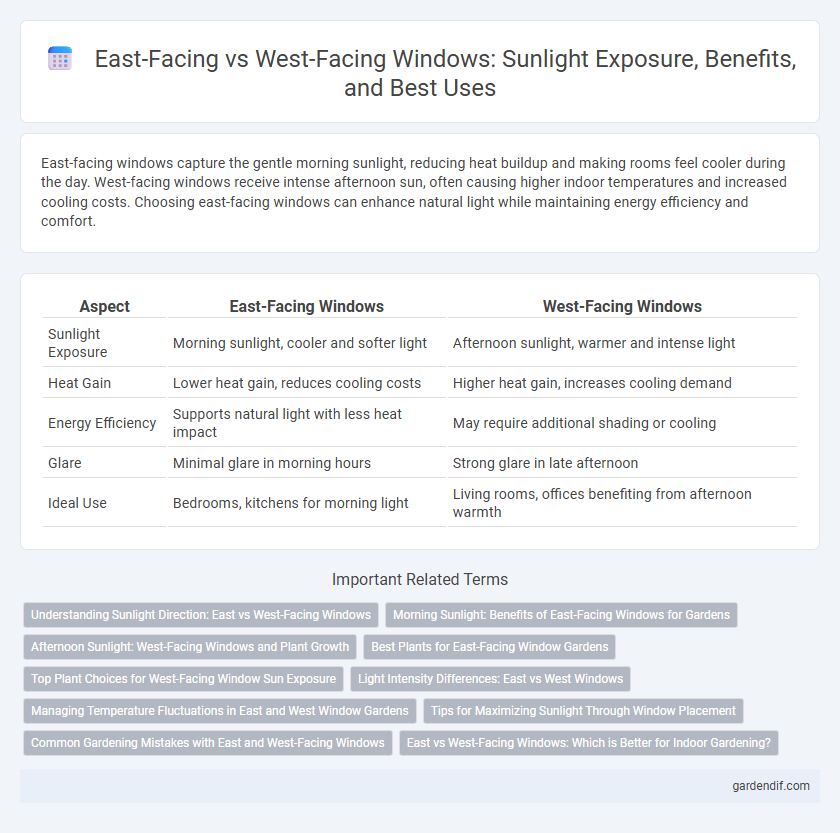
East-facing windows vs west-facing windows Illustration
East-facing windows capture the gentle morning sunlight, reducing heat buildup and making rooms feel cooler during the day. West-facing windows receive intense afternoon sun, often causing higher indoor temperatures and increased cooling costs. Choosing east-facing windows can enhance natural light while maintaining energy efficiency and comfort.
Table of Comparison
| Aspect | East-Facing Windows | West-Facing Windows |
|---|---|---|
| Sunlight Exposure | Morning sunlight, cooler and softer light | Afternoon sunlight, warmer and intense light |
| Heat Gain | Lower heat gain, reduces cooling costs | Higher heat gain, increases cooling demand |
| Energy Efficiency | Supports natural light with less heat impact | May require additional shading or cooling |
| Glare | Minimal glare in morning hours | Strong glare in late afternoon |
| Ideal Use | Bedrooms, kitchens for morning light | Living rooms, offices benefiting from afternoon warmth |
Understanding Sunlight Direction: East vs West-Facing Windows
East-facing windows receive morning sunlight, providing bright, gentle light that helps warm rooms early but cools down by afternoon. West-facing windows capture intense afternoon and evening sunlight, leading to warmer indoor temperatures and potential glare later in the day. Understanding sunlight direction helps optimize energy efficiency and indoor comfort based on window orientation.
Morning Sunlight: Benefits of East-Facing Windows for Gardens
East-facing windows capture abundant morning sunlight, providing optimal light intensity for photosynthesis and promoting healthy plant growth. Morning sun reduces the risk of overheating and excessive evaporation compared to afternoon sun exposure through west-facing windows. This gentle, nutrient-rich light enhances flowering and fruiting cycles, making east-facing windows ideal for indoor gardens and sensitive plant species.
Afternoon Sunlight: West-Facing Windows and Plant Growth
West-facing windows receive strong, direct sunlight in the afternoon, providing plants with intense light essential for photosynthesis and robust growth. This exposure helps heat-loving and sun-tolerant plants thrive by boosting their energy production during peak daylight hours. However, prolonged afternoon sun can cause leaf scorch or dehydration in sensitive species, so appropriate watering and shading strategies are crucial for optimal plant health.
Best Plants for East-Facing Window Gardens
East-facing windows provide moderate, indirect sunlight ideal for shade-tolerant and low-light plants such as ferns, snake plants, and African violets. These windows receive gentle morning light that promotes healthy growth without the harsh midday sun stress faced by west-facing windows. Plants like peace lilies, spider plants, and begonias thrive in east-facing gardens due to the balanced exposure that supports vibrant foliage and flowering.
Top Plant Choices for West-Facing Window Sun Exposure
West-facing windows receive intense afternoon sunlight, ideal for sun-loving plants such as succulents, aloe vera, and jade plants that thrive in bright, direct light. Heat-tolerant herbs like basil and rosemary also flourish in this sun exposure, benefiting from the strong light and warmth. To maximize growth, choose drought-resistant varieties and ensure adequate watering to prevent soil from drying out too quickly in the harsh afternoon sun.
Light Intensity Differences: East vs West Windows
East-facing windows receive intense morning sunlight, providing bright and cooler light that gradually diminishes by midday. West-facing windows experience weaker morning light but are exposed to stronger, warmer afternoon sunlight, resulting in higher light intensity during the late day. This variation in light intensity affects indoor temperature regulation, plant growth, and energy efficiency in buildings.
Managing Temperature Fluctuations in East and West Window Gardens
East-facing windows receive gentle morning sunlight that helps warm plants gradually, reducing temperature spikes and preventing heat stress in garden spaces. West-facing windows expose gardens to intense afternoon sun, causing higher temperature fluctuations and increasing the risk of overheating. Implementing shade curtains or heat-resistant plant varieties can effectively manage temperature variations in both east and west window gardens.
Tips for Maximizing Sunlight Through Window Placement
East-facing windows capture gentle morning sunlight that can warm and brighten your home early in the day, making them ideal for bedrooms and kitchens. West-facing windows provide intense afternoon sunlight, offering natural warmth but may require window treatments like blinds or shades to reduce glare and heat buildup. Position furniture and reflective surfaces near these windows to enhance light distribution and use deciduous trees outside west-facing windows for seasonal shading.
Common Gardening Mistakes with East and West-Facing Windows
East-facing windows provide morning sunlight that is gentle and ideal for many indoor plants, reducing the risk of leaf burn and overheating common with west-facing windows. West-facing windows expose plants to intense afternoon sun, often causing common gardening mistakes such as scorched leaves and rapid soil drying. Proper plant selection and monitoring soil moisture are crucial to prevent stress and ensure healthy growth near these differently oriented windows.
East vs West-Facing Windows: Which is Better for Indoor Gardening?
East-facing windows provide gentle, morning sunlight that supports steady plant growth by preventing overheating and excessive light intensity, ideal for most indoor plants. West-facing windows receive intense afternoon sunlight, which benefits heat-loving plants but may cause leaf burn and require increased watering. Choosing between east and west-facing windows depends on plant type, with east-facing windows generally preferred for balanced light and temperature control in indoor gardening.
East-facing windows vs west-facing windows Infographic

 gardendif.com
gardendif.com